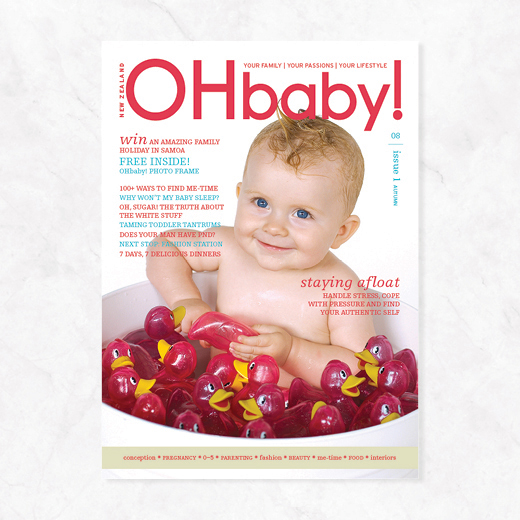Tips for coping with toddler tantrums

Kicking and screaming, wailing and whining, foot stamping, floor pounding, arm flapping... No, it's not performance art, it's a toddler tantrum. Here's how to cope with your little one's amateur dramatics - and keep your sanity.
Simply saying the phrase "temper tantrum" sends shivers down the spines of many parents. Toddler tantrums are annoying and frustrating, but, unfortunately, they're rather common during the toddler and preschool years. Most children will exhibit these, and some more than others. This can depend on their temperament, the match of the child with their parents' personalities, and the use and implementation of parenting strategies.
Tantrums do vary somewhat in what they look like. They can be the common "rolling on the ground, pounding arms and feet while screaming" variety or, while standing, can include stomping, crying or screaming. Your child may hold their breath, go floppy, arch their back, or give you the silent treatment. My youngest child throws tantrums with a scowling face while folding her arms in defiant determination. It makes quite a picture (and let's not ask where she gets this from).
WHY DOES MY CHILD THROW TANTRUMS?
Developmentally, tantrums are simply a child's means of communication. She is expressing herself in the only way she knows how, until she learns to communicate and use better, alternative means. Tantrums are your child's way of communicating her displeasure with the turn of events, her frustration in not being able to do something, have something, or at having to wait (which most are not yet good at).
It is helpful to view this phase as a child's time to learn the elementary steps of emotional self-regulation, given that the parent does not respond in such a way that the child learns to think, "Hey, this gets me what I want!" If a child learns this, you may have created a little tyrant who will hold you to ransom with the threat of a tantrum. Don't panic if this sounds like your child and you are tiptoeing around them in fear of an outburst. Remember, it is a learned behaviour and change is possible with the use of new strategies on your part.
Tantrums naturally occur more often when your child is hungry, tired or over-stimulated, as these are the times when emotional self-regulation is hard. Just as when you or I are sleep-deprived, we become more irritable, impatient and easily angered. Set up helpful routines to avoid tiredness and hunger, helping everyone cope and plan. Don't forget to also provide plenty of exercise for your child so she is not wired with pent-up energy that needs to be released, causing havoc in the house.
CHECK YOUR EXPECTATIONS
Parental expectations can be instrumental in this, too. If your expectations are too high, your child can never meet them and will feel disappointed and frustrated - for example, a two-year-old being asked to put books back on a shelf. This is a tall order, and sets both the parent and child up for disappointment, which could very likely end in a tantrum. A preschooler may be able to do a super tidy-up job occasionally, and increasingly share nicely. However, they are easily distracted and consistent behaviour may not be realistic as yet. Parental support and assistance is still necessary - it's a bit like training wheels on a bike. You still need to catch your child or hold her, rather than letting her fly down the hill with no assistance. So expecting 100% compliance sets you and your child up for failure, frustration and disappointment and, consequently, a likely tantrum.
Expectations that are too low, meaning you as a parent do too much for your child, cause your child to miss out on learning opportunities and practice. In turn, her skills are not given the chance to develop, and she will feel frustrated at her inability with the parent often taking over. Consequently, tantrums will ensue in protest at the lack of opportunity.
PREVENTION IS KEY
So how should a parent respond to a child having a tantrum? First, check preventative options. Are there common triggers that can be eliminated? Are there common times of the day when tantrums are driving you crazy? Maybe routines can be changed to better accommodate the child's needs and minimise tantrums. For example, four-year-old George is asked, "What would you like to wear today?" by his mum. George chooses his favourite jumper. Alas, it's a hot day so his mum says, "No, George, it's too hot for that." But George insists on the jumper, then throws a tantrum when his mum won't budge. Alternatively, if George's mum gave George an option of two possible T-shirts, the jumper tantrum could have been avoided.
The rule of thumb, therefore, is: Only give choices when they are genuinely available. Providing options of two or three choices works well for this age group: "Would you like peanut butter or jam on your toast?" is better than "What would you like on your toast?"
Another example is three-year-old Sarah, who is picked up from daycare at 5.30pm each evening. She's tired and hungry. They arrive home and her parents begin to make dinner, while Sarah is grumpy and whiny, and tantrums happen at the drop of a hat. Sarah's parents are frustrated because they want the little time they have with her in the evening to be quality time, not full of tension and frustration. So, alternatively:
1. Sarah's parents could arrange to take turns picking Sarah up while the other parent goes home to make dinner so it's ready on their arrival.
2. Sarah's parents could arrange to leave earlier from work so that Sarah can be picked up earlier.
3. Sarah's parents could arrange for one parent to cut back his or her working hours, or perhaps explore the option of working more flexible hours so that Sarah can get home earlier.
4. Snacks (as part of Sarah's dinner) are prepared for her to eat in the car on their way home, such as carrot sticks, cherry tomatoes, cucumber rings, pita bread, etc. Upon arrival home, Sarah is bathed by one parent, while the other parent prepares the rest of the meal.
It's always better to investigate the cause and try to prevent tantrums before simply heading for the discipline route.
ATTENTION-SEEKING
Can a tantrum be an example of attention-seeking behaviour on a child's part? Yes, unfortunately, tantrums are sometimes done for our benefit alone! This is especially so if we pay lots of attention to the tantrum and give little attention to the child generally. Any attention is better than no attention.
Are you always too busy, saying to your child, "Just a minute!" "Soon!" "Hang on!" and the like? Children love and need their parents' attention, so hug, cuddle, wrestle, talk and read, praise and encourage, do puzzles, crafts, cooking… All of these are important aspects of providing emotional security for your child. In such a family environment, children know that you are available to them, providing emotional contentment. This does not translate to being with them all the time - children like having frequent small amounts of time, too.
PREPARATION
Prepare your child for change. When you have to leave the house, the swimming pool or a friend's house, provide your child with a warning to let her know that she's leaving soon. This helps many children cope with the upcoming change and possible disappointment of having to leave, rather than to be suddenly asked to go, especially if they're in the middle of playing.
STRATEGIES FOR COPING
Even in the most wonderful and well-rounded families, tantrums still occur. So how then can we minimise these and, at the same time, teach our children better alternatives and emotional self-regulation?
• Model calmness. If you have rages and outbursts of anger yourself, do these away from the children and perhaps learn some anger-management strategies or relaxation techniques. Check out local courses and support for this.
• If your child is still young and not able to talk much, and is heading into a tantrum, tell him, "Matthew, stop crying, and listen with your ears," followed with an instruction, such as, "Let's put the puzzle away."
• Attempt to redirect her. Praise her if she cooperates: "That's good listening, Sarah!" Should the tantrum continue, ignore your child completely until she is finished. Simply wait it out.
• Stay calm. Remain persistent and consistent in your approach. Perhaps you'll need to think of some ways to support you to remain calm, such as taking five deep breaths, counting to 20, walking to the letterbox and back, or turning on some music.
• Do not try to console, talk or reason with her. Your child is in no shape to listen to anything until she has calmed down. When she is calm, comfort her but do not give in to the demand that was the cause of the tantrum.
• Attempt to say yes rather than always saying no. You can change many no's into yes's - "Yes, you can play after you have put your pyjamas under your pillow," or "Yes, you may have a snack when we get home," or "Yes, you can have dessert after you have finished your sandwich."
• For preschoolers who have tantrums, provide them with an instruction to change their behaviour. Keep it short and to the point, such as "Sam, stop screaming. I can see that you're angry. Let's come back to colouring the picture after dinner, and I'll help you."
• Should he continue to scream, take him to quiet time. Quiet time is a set space in the social part of the house, such as the steps leading down to the lounge, a special rug, a stool, or chair in the dining room that is away from foot traffic, and should not be a place from where the TV can be watched. When quiet time is necessary, place your child in this spot for a set period of time (a half-minute for every year of age, so a four-year-old would be in quiet time for two minutes). While he is in quiet time, he must sit still and be quiet.
• If your child cannot follow those two rules of quiet time, she is then promptly taken to time out, while you state this to her: "Julia, you have not stayed in quiet time, so now you'll have to go to time out." Time out should be a boring, safe place that is away from the social environment, such as the laundry room, a bathroom, an office, the hallway, or a spare bedroom. Prepare it before you need it. Take your child to time out for the same amount of time as quiet time (a half-minute for every year of your child's age); however, do not start timing her until she is quiet!
• Go over the rules. Before using quiet time or time out, and when you are not in the middle of a problem behaviour, take your child through the rules of quiet time and time out. You could make it fun and role-play being the child who throws tantrums! Check that your child understands the concept. Then use it and be consistent, calm and patient. Emotional regulation is not achieved in three days!
Be sure to support one another as parents in managing your child's tantrums in the same way. If you and your partner have differences of opinion in how you handle tantrums, discuss this away from your child and do not be tempted to intervene with the other parent's management unless there is danger of serious harm.
Remember, Rome was not built in a day! Stick with it and a reduction will be seen over a week to two. Keep the focus on being positive and noticing positive behaviour, and have a lot of fun together when you are not in the middle of a tantrum. Take heart that this too will pass, especially when consistent, skillful parenting strategies are employed.
by Pauline Ogilvy

AS FEATURED IN ISSUE 1 OF OHbaby! MAGAZINE. CHECK OUT OTHER ARTICLES IN THIS ISSUE BELOW

















